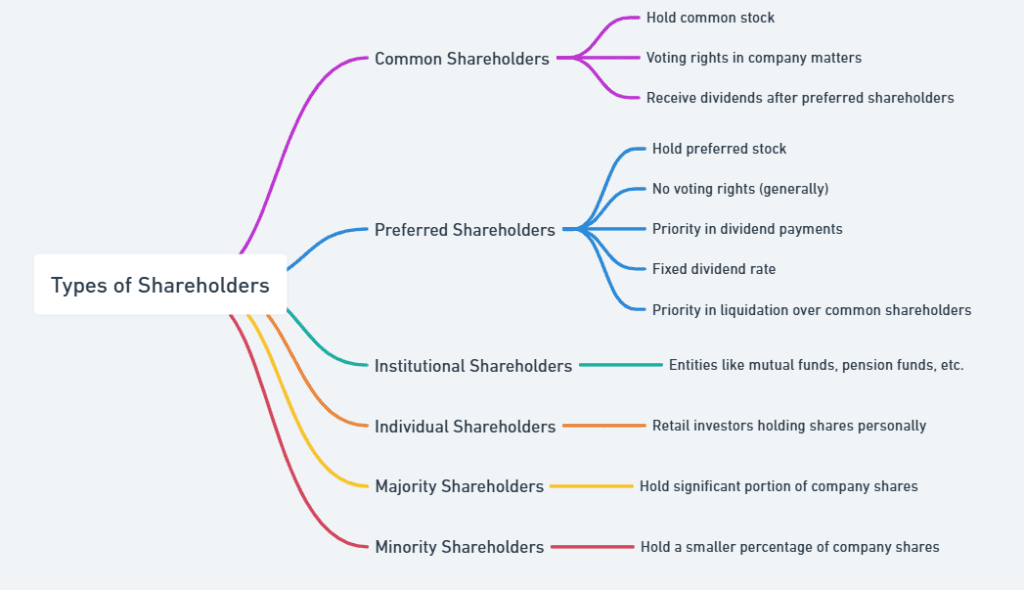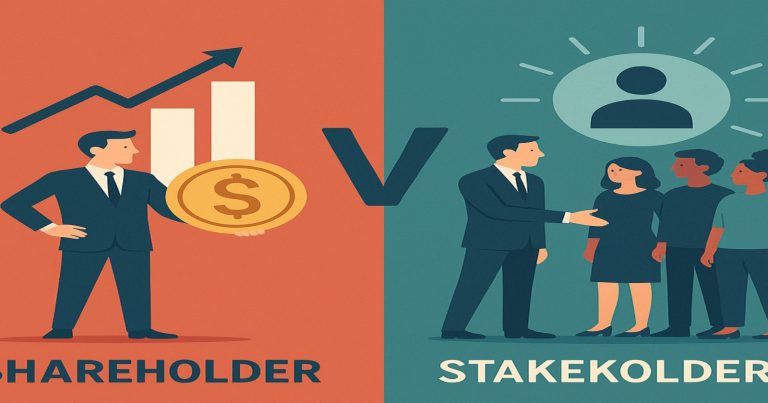Stakeholders and shareholders are pivotal in most company strategies, but their focus, scope, and influence are drastically different. They are the most fundamental comprehension of corporate operations and governance. A shareholder is someone who owns or holds shares in a company and, as such, is partially an owner. Instead, stakeholder refers to a larger group affected by its activities, which may include employees, customers, communities, and even regulatory bodies. While shareholders are primarily concerned with financial returns, stakeholders emphasize the company’s broader impact, including ethical and environmental considerations.
Stakeholder vs Shareholder: Key Differences
While shareholders are only concerned with companies’ overall performance in terms of environmental, social, and governance (ESG) impact, the stakeholders are owner in the overall performance of the company. The table below outlines the fundamental differences between stakeholders and shareholders:
| Aspect | Stakeholder | Shareholder |
|---|---|---|
| Definition | A person or group affected by the company’s actions. | A person or entity owning company shares. |
| Connection | Broader connection beyond financial interest. | Direct connection through share ownership. |
| Scope | Includes employees, customers, suppliers, government, and communities. | Limited to individuals or entities owning shares. |
| Objective | Interested in long-term sustainability and ethical practices. | Primarily focused on financial returns and dividends. |
| Examples | Employees, creditors, local communities, and customers. | Institutional investors, individuals, and mutual funds. |
| Legal Rights | No direct legal rights to financial assets. | Voting rights and claim to dividends. |
| Time Horizon | Concerned with both short-term and long-term impacts. | Often focuses on quarterly or annual results. |
- Wider Impact: The stakeholders are the internal and external groups that interact with the company, hence highlighting a way of conducting business sustainably. Shareholders, however, are narrower in focus and concentrate on financial measures such as stock price and dividends.
- Rights and Influence: Shareholders have a direct influence on corporate decisions through voting rights. On the other hand, stakeholders often have informal influence through campaigns of ethical practices or enforcing regulatory compliance.
- Conflict of Interest: This means that in pursuing the highest profit, shareholders may sometimes conflict with the concerns of stakeholders, such as environmental sustainability and employee welfare.
By balancing the interests of stakeholders and shareholders, companies ensure long-term growth and profitability while maintaining ethical standards.
What is a Shareholder?
A shareholder is a part owner in a firm, being an individual, corporation, or institution holding shares in the company. Shareholders are consequently legally recognized and derive financial benefits in the form of returns, normally through dividends and capital gains whenever the company operates successfully.
Role of Shareholders in a Company
- Ownership: Shareholders own equity in the company and have a claim on its earnings and assets.
- Decision-Making: They exercise their voting rights during general meetings, influencing critical decisions like electing the board of directors or approving mergers.
- Risk and Reward: Shareholders assume financial risks when investing in a company. They share in its profits but also bear potential losses.
Shareholders play a pivotal role in ensuring the company remains profitable and competitive, focusing on financial performance indicators such as earnings per share (EPS).
Types of Shareholders
Understanding the category of shareholders will help in determining their respective roles and priorities in a firm. Commonly, shareholders are divided into common and preferred shareholders.
Common Shareholders
Common shareholders are the primary owners of a company’s equity. Anyone who owns common stock in a company can vote on corporate policies and elect members of your board of directors. However, common shareholders shoulder a bit more risk—if a company is liquidated, they can only claim assets after bondholders, preferred shareholders, and other debtholders have been paid in full.
- Rights and Privileges:
- Voting rights in corporate decisions, including board elections and significant policy changes.
- Entitlement to dividends, which may vary depending on the company’s profitability.
- Residual claims on assets after creditors and preferred shareholders are paid during liquidation.
- Risk Factors:
- Greater exposure to financial losses during downturns.
- Dividends are not guaranteed and depend on the company’s performance.
Preferred Shareholders
Preferred shareholders have a higher claim on a company’s earnings and assets compared to common shareholders but lack voting rights. Preferred shareholders usually can’t vote on policies or elect board members, so they don’t have a say in a company’s future. However, they take on a bit less risk—if a company is liquidated, preferred shareholders can claim assets before common stakeholders.
- Key Characteristics:
- Fixed dividend payouts, providing a predictable income stream.
- Priority over common shareholders in asset distribution during liquidation.
- Limited or no participation in corporate decision-making.
- Advantages:
- Less exposure to financial volatility compared to common shareholders.
- Greater financial security due to fixed dividends.
The coexistence of these shareholder types ensures a balance between equity financing and investor preferences, catering to both risk-tolerant and risk-averse investors.

What is a Stakeholder?
A stakeholder refers to any individual or group who has an interest in the operations, decisions, and general performance of a business. In this regard, stakeholders encompass employees, customers, suppliers, creditors, regulators, and local communities.
Role of Stakeholders in a Company
Stakeholders influence the strategy of corporations by increasing awareness related to sustainability, ethical practices, and operations efficiency. Their suggestions also help companies to make responsible decisions, thus creating goodwill and increasing brand value.
Types of Stakeholders
Stakeholders can be divided into two categories: internal and external. This distinction helps businesses identify and address their concerns effectively.
Internal Stakeholders
Internal stakeholders are directly involved in the company’s operations. Internal stakeholders are people who have a direct relationship with your company, like your teammates and cross-functional partners. They’re often employed by your company, but not always. Internal stakeholders are instrumental in daily operations and directly influence the company’s performance and culture.
Examples:
- Employees: Depend on the company for job security, wages, and career growth. They contribute to achieving organizational goals.
- Managers: Align business operations with strategic objectives and ensure profitability.
- Owners/Founders: Invest time and resources to establish and grow the company, focusing on long-term success.
External Stakeholders
External stakeholders are not part of the company’s internal structure but are significantly affected by its actions. Even though external stakeholders are outside your organization, your project still impacts them in some way. External stakeholders ensure the company operates responsibly and maintains a positive public image.
- Examples:
- Customers: Expect high-quality products and services, influencing revenue generation.
- Suppliers: Depend on the company for consistent orders and payments.
- Regulators: Ensure legal compliance and monitor the company’s impact on society.
- Communities: Evaluate the company’s social responsibility, including environmental conservation and ethical practices.
Conclusion
The key difference between a stakeholder and a shareholder is the area of interest and influence, while shareholders invest financially for profit, stakeholders are a more general and predominant group of people affected by what the organization does. A balanced approach that considers both is essential to sustain growth and ensure ethical business practice. The company must therefore align its strategy to meet financial performance requirements take into account the concerns of its stakeholders and take advantage of being competitive in a socially conscious world.
Stakeholder and Shareholder FAQs
What is the difference between stakeholder and shareholder focus?
Shareholders prioritize financial returns, while stakeholders focus on broader impacts like sustainability, ethical practices, and community welfare.
Can stakeholders and shareholders have conflicting interests?
Yes, conflicts arise when shareholders prioritize profits at the expense of stakeholder concerns, such as employee welfare or environmental conservation.
Why are stakeholders essential for long-term success?
Stakeholders ensure the company operates ethically, responsibly, and sustainably, fostering trust and goodwill.
Do all stakeholders have financial interests in a company?
No, some stakeholders, like communities or environmental groups, are primarily concerned with the company’s non-financial impact.
How do shareholders influence company decisions?
Shareholders vote on key matters such as board elections, mergers, and dividend policies, directly shaping corporate governance.


